Machinery sharing co-ops are hugely popular across France, with over 50% of farmers there being part of such groups.
After a visit to the Contrevents Verts Co-op in the northwest of France in 2017, followed by several years of research and consideration, four west Cork dairy farmers made the decision to set up a machinery co-op of their own to share a slurry tanker, fitted with a trailing shoe.
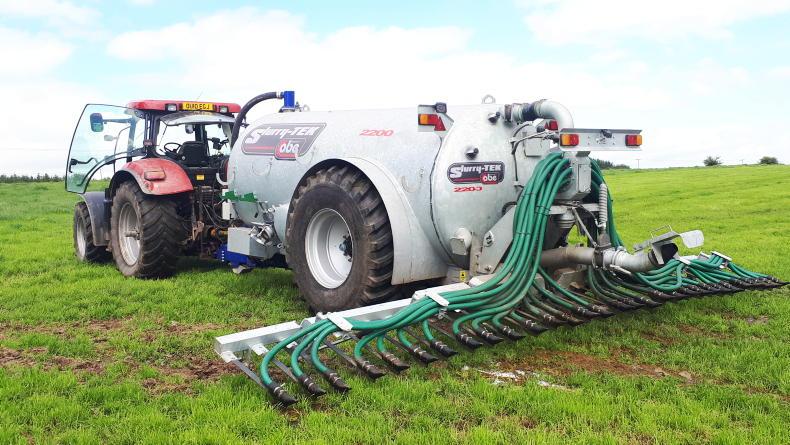
The objective of any machinery co-operative is to make machinery more available to co-op members at a lower cost than if they were to individually buy the machinery.
Farmers sharing machinery isn’t new, but these four farmers created the first CUMA machinery-sharing co-operative in Ireland. Twelve months on from the arrival of the tanker, we caught up with the four farmers involved to see how their first year went.
Who’s involved?
The four farmers involved are Brendan Hinchion, Colm Kelleher, Patrick McSweeney and John Wood. All four are dairying (milking between 80-200 cows) and have been a part of the Kilnamartrya discussion group for the last 20 years, so they know each other very well. Three are living within five miles of each other, while the other member is a 30-minute drive away.
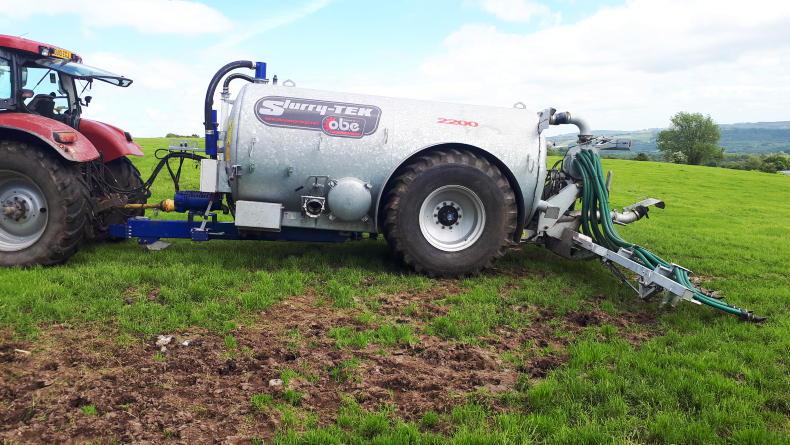
The initiative was backed and developed by Teagasc, the Department of Agriculture and the Irish Co-operative Organisation Society (ICOS).
Individually, the four farmers felt they couldn’t justify the sizeable investment in a new slurry tanker with a trailing shoe. However, collectively, they could justify a top-spec tanker with all the bells and whistles.
Where did the idea come from?
Some members of the Kilnamartyra discussion group have been taking in French students on work experience exchanges for up to 20 years and have often heard about how machinery sharing co-ops work in France, and their widespread success.
Interested to find out more, the discussion group decided to go to France and visit such a group for their annual trip away in 2017. They visited the Contrevents Verts Co-op, which was established over 30 years ago.

L/R- Colm Kelleher, Patrick McSweeney, Brendan Hinchion and
John Wood.
This group owns a fleet of over 45 machines, including tractors, balers, ploughs, harrows, sub-soilers, trailers and dung spreaders.
With 37 members and nine committee members, the co-op also built its own solar-powered shed. When it wants to buy a machine, it puts 20% of its value into the CUMA share capital and borrows the rest.
The next step
Fourteen members from the discussion group made the visit to France. Some members didn’t agree with the concept, while labour availability was an issue for others. The number interested was soon whittled down to four who were truly interested in proceeding with the co-op type system. With great help from Teagasc’s Thomas Curran, Comharcumann Gleann an Laoi (the name chosen for the west Cork machinery co-op) was registered with the Friendly Societies Register for co-operatives in November 2018. 
When spec’ing the machine, no expense was spared, with notable features including a lazy arm, an inlet macerator and galvanising. The retail price paid for the tanker by the machinery co-op in November 2019 was €48,000 including VAT.
How does the co-op work?
The objective of any machinery co-operative is to make machinery more available to co-op members at a lower cost than if they were to individually buy the machinery. It is designed to operate as a non-profit, breakeven entity. It essentially provides a business structure for the sharing of machinery between farmers.
The co-op buys the machine and then the farmers hire it from the co-op. A rule book, largely adopted from the French system, has been drafted which features outcomes to every possible situation.
Based on the individual usage of the machine, the co-op rents out the machinery to the members. The members contribute 20% of the machine purchase price as share capital. The remaining capital balance is then financed. In this example, the three farmers who invested share capital hire the tanker from the co-op for a fixed hourly fee.
The fourth member didn’t actually put up any share capital, but he is still a co-op member and his daily hire rate is higher. In the French system, people who didn’t put up any share capital pay a 20% higher rate, which covers the depreciation and repairs.
The rental fees ensure the co-op will have funds available to repay bank loans and cover running costs, including repairs and maintenance, depreciation of the machine and administration costs.
The French system depreciates the cost of the machine over an eight-year period. In the west Cork example, the loan, insurance, depreciation and miscellaneous expenses and repairs amounted to a yearly figure of €8,000. The machine was used for 480 hours work between the four farmers, meaning hire costs have worked out in the region of €15 to €17 per hour.
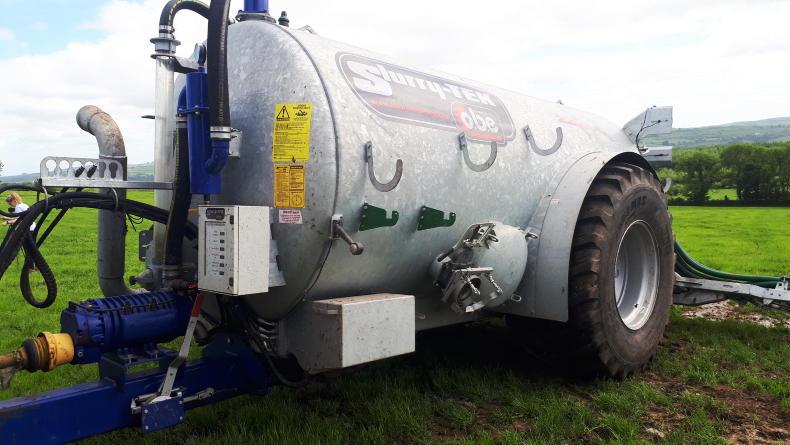
Once finished with the machine, all details such as the date of use and how many hours it accumulated during the job are documented.
This usage rate is high, but its based on the French model which ensures there’s a substantial sum in the kitty when it comes to purchasing the replacement machine.
The group are currently deliberating whether to continue with this method, or to drop the rate by €4 per hour and leave the replacement machine to stand on its own footing.
Booking the machine
When one of the farmers wants the machine, he drops a message into the WhatsApp group chat, noting that he is looking to book the tanker for a certain day next week. It’s booked on a day-by-day basis, but with just four members, availability is rarely an issue. When it is booked, the farmer using it aims to keep the machine working, so its use is maximised and it’s fair to the other farmers.
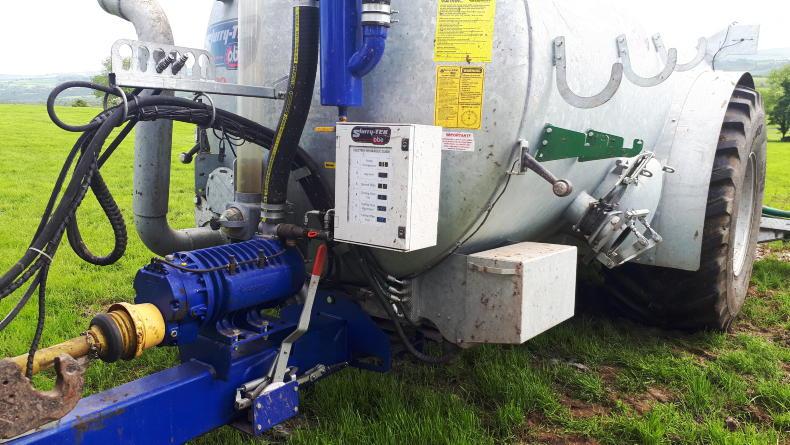
Once finished, the user is required to grease and wash it, before taking a walk around and ensuring there are no issues, just like signing off a rental car.
Once finished with the machine, all details such as the date of use and how many hours it accumulated during the job are written in a book that is stored in a compartment on the tanker.
The slurry tanker also has its own odometer to record hours used. A photo of both is taken and shared with the group, so everyone is up to date at all times.
Once finished, the user is required to grease and wash the machine, before taking a walk around to ensure there are no issues, just like signing off a rental car.
If the user damages the machine, they must replace the damaged part. If a component is worn, it is replaced from the co-op’s kitty. Once washed, the machine is safely parked at that yard until the next farmer wants it, and he must travel to collect it.
The tanker
The tanker was selected to match the farmers’ undulating terrain. They were after a low centre of gravity machine and came to the conclusion that OBE in Co Armagh was the right company for them.

"Its vital that you know the people involved in the co-op, and that they are reasonable. It’s a bit like getting married"!
The west Cork farmers decided to go with a 2,200-gallon tanker with a 7.5m trailing shoe. The group did note that there were some teething issues with the outfit, but that these have since been rectified.
In terms of specification, no expense was spared, with some notable features including a lazy arm, an inlet macerator and galvanising.
The retail price paid for the tanker by the machinery co-op in November 2019 was €48,000 including VAT.
Who helped to set it up?
The initiative was backed and developed by Teagasc, the Department of Agriculture and the Irish Co-operative Organisation Society (ICOS).
When forming the co-op, the members met Department of Agriculture representatives who decided to introduce new rules, allowing the co-op to draw down a 40% grant aid (€12,000) for the investment.
The co-op model was created with ICOS, while the new rule book was drafted and adapted from the French system with Teagasc.
Decisions in the co-op are made through a democratic voting process, with each member having one vote in any decision regardless of the number of shares they own.
A board was also formed, with members electing a chair, secretary and treasurer to run the co-op on an ongoing basis, while also implementing the rules as created by the members.
One year on –
what’s the verdict to date?
“We are delighted with how our first year has gone. Everything worked very smoothly, even more so than we had anticipated.
“The key was to set out definite rules for every possible potential issue before the tanker had arrived. It’s also vital that you know the people involved in the co-op, and that they are reasonable. It’s a bit like getting married! We have all been in the same discussion group for 20 years and have an excellent relationship amongst ourselves.
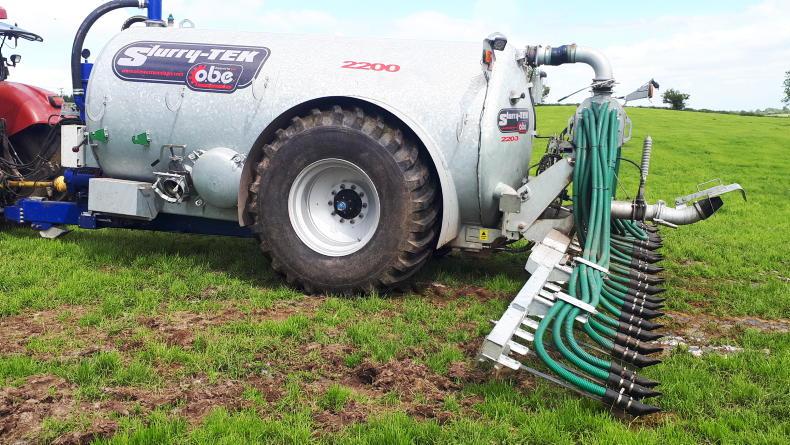
The slurry tanker also has its own odometer to record hours used.
“The other important factor which helped things work trouble free was the number in the group. With it available to just four users, the machine wasn’t stretched thin and it was available on a regular basis. If we had for example six or seven in the group, this might have led to a different outcome. On the other hand, the more people you have in the co-op, then the cheaper it will be to access such machinery. But we felt that for a slurry tanker, four was a good number.
“If we had spent €50,000 each on a slurry tanker and trailing shoe, we felt that we would have had to get the very most from it. By going this route, its costing us a fraction of the total cost and we can still avail of contractors when we are very busy such as the early spring. We didn’t go this route to replace our contractors, but to also add the flexibility of spreading lower volumes of slurry per application, such as loads here and there following the grazing rotation.
“Based on this year’s success, we do intend to build on it slowly and are considering buying more machines. The next item we are looking at is a bale trailer. Overall, the co-op has worked well and we would recommend it to other like-minded farmers,” explained the group.
Machinery sharing co-ops are hugely popular across France, with over 50% of farmers there being part of such groups.
After a visit to the Contrevents Verts Co-op in the northwest of France in 2017, followed by several years of research and consideration, four west Cork dairy farmers made the decision to set up a machinery co-op of their own to share a slurry tanker, fitted with a trailing shoe.

The objective of any machinery co-operative is to make machinery more available to co-op members at a lower cost than if they were to individually buy the machinery.
Farmers sharing machinery isn’t new, but these four farmers created the first CUMA machinery-sharing co-operative in Ireland. Twelve months on from the arrival of the tanker, we caught up with the four farmers involved to see how their first year went.
Who’s involved?
The four farmers involved are Brendan Hinchion, Colm Kelleher, Patrick McSweeney and John Wood. All four are dairying (milking between 80-200 cows) and have been a part of the Kilnamartrya discussion group for the last 20 years, so they know each other very well. Three are living within five miles of each other, while the other member is a 30-minute drive away.

The initiative was backed and developed by Teagasc, the Department of Agriculture and the Irish Co-operative Organisation Society (ICOS).
Individually, the four farmers felt they couldn’t justify the sizeable investment in a new slurry tanker with a trailing shoe. However, collectively, they could justify a top-spec tanker with all the bells and whistles.
Where did the idea come from?
Some members of the Kilnamartyra discussion group have been taking in French students on work experience exchanges for up to 20 years and have often heard about how machinery sharing co-ops work in France, and their widespread success.
Interested to find out more, the discussion group decided to go to France and visit such a group for their annual trip away in 2017. They visited the Contrevents Verts Co-op, which was established over 30 years ago.

L/R- Colm Kelleher, Patrick McSweeney, Brendan Hinchion and
John Wood.
This group owns a fleet of over 45 machines, including tractors, balers, ploughs, harrows, sub-soilers, trailers and dung spreaders.
With 37 members and nine committee members, the co-op also built its own solar-powered shed. When it wants to buy a machine, it puts 20% of its value into the CUMA share capital and borrows the rest.
The next step
Fourteen members from the discussion group made the visit to France. Some members didn’t agree with the concept, while labour availability was an issue for others. The number interested was soon whittled down to four who were truly interested in proceeding with the co-op type system. With great help from Teagasc’s Thomas Curran, Comharcumann Gleann an Laoi (the name chosen for the west Cork machinery co-op) was registered with the Friendly Societies Register for co-operatives in November 2018. 
When spec’ing the machine, no expense was spared, with notable features including a lazy arm, an inlet macerator and galvanising. The retail price paid for the tanker by the machinery co-op in November 2019 was €48,000 including VAT.
How does the co-op work?
The objective of any machinery co-operative is to make machinery more available to co-op members at a lower cost than if they were to individually buy the machinery. It is designed to operate as a non-profit, breakeven entity. It essentially provides a business structure for the sharing of machinery between farmers.
The co-op buys the machine and then the farmers hire it from the co-op. A rule book, largely adopted from the French system, has been drafted which features outcomes to every possible situation.
Based on the individual usage of the machine, the co-op rents out the machinery to the members. The members contribute 20% of the machine purchase price as share capital. The remaining capital balance is then financed. In this example, the three farmers who invested share capital hire the tanker from the co-op for a fixed hourly fee.
The fourth member didn’t actually put up any share capital, but he is still a co-op member and his daily hire rate is higher. In the French system, people who didn’t put up any share capital pay a 20% higher rate, which covers the depreciation and repairs.
The rental fees ensure the co-op will have funds available to repay bank loans and cover running costs, including repairs and maintenance, depreciation of the machine and administration costs.
The French system depreciates the cost of the machine over an eight-year period. In the west Cork example, the loan, insurance, depreciation and miscellaneous expenses and repairs amounted to a yearly figure of €8,000. The machine was used for 480 hours work between the four farmers, meaning hire costs have worked out in the region of €15 to €17 per hour.

Once finished with the machine, all details such as the date of use and how many hours it accumulated during the job are documented.
This usage rate is high, but its based on the French model which ensures there’s a substantial sum in the kitty when it comes to purchasing the replacement machine.
The group are currently deliberating whether to continue with this method, or to drop the rate by €4 per hour and leave the replacement machine to stand on its own footing.
Booking the machine
When one of the farmers wants the machine, he drops a message into the WhatsApp group chat, noting that he is looking to book the tanker for a certain day next week. It’s booked on a day-by-day basis, but with just four members, availability is rarely an issue. When it is booked, the farmer using it aims to keep the machine working, so its use is maximised and it’s fair to the other farmers.

Once finished, the user is required to grease and wash it, before taking a walk around and ensuring there are no issues, just like signing off a rental car.
Once finished with the machine, all details such as the date of use and how many hours it accumulated during the job are written in a book that is stored in a compartment on the tanker.
The slurry tanker also has its own odometer to record hours used. A photo of both is taken and shared with the group, so everyone is up to date at all times.
Once finished, the user is required to grease and wash the machine, before taking a walk around to ensure there are no issues, just like signing off a rental car.
If the user damages the machine, they must replace the damaged part. If a component is worn, it is replaced from the co-op’s kitty. Once washed, the machine is safely parked at that yard until the next farmer wants it, and he must travel to collect it.
The tanker
The tanker was selected to match the farmers’ undulating terrain. They were after a low centre of gravity machine and came to the conclusion that OBE in Co Armagh was the right company for them.

"Its vital that you know the people involved in the co-op, and that they are reasonable. It’s a bit like getting married"!
The west Cork farmers decided to go with a 2,200-gallon tanker with a 7.5m trailing shoe. The group did note that there were some teething issues with the outfit, but that these have since been rectified.
In terms of specification, no expense was spared, with some notable features including a lazy arm, an inlet macerator and galvanising.
The retail price paid for the tanker by the machinery co-op in November 2019 was €48,000 including VAT.
Who helped to set it up?
The initiative was backed and developed by Teagasc, the Department of Agriculture and the Irish Co-operative Organisation Society (ICOS).
When forming the co-op, the members met Department of Agriculture representatives who decided to introduce new rules, allowing the co-op to draw down a 40% grant aid (€12,000) for the investment.
The co-op model was created with ICOS, while the new rule book was drafted and adapted from the French system with Teagasc.
Decisions in the co-op are made through a democratic voting process, with each member having one vote in any decision regardless of the number of shares they own.
A board was also formed, with members electing a chair, secretary and treasurer to run the co-op on an ongoing basis, while also implementing the rules as created by the members.
One year on –
what’s the verdict to date?
“We are delighted with how our first year has gone. Everything worked very smoothly, even more so than we had anticipated.
“The key was to set out definite rules for every possible potential issue before the tanker had arrived. It’s also vital that you know the people involved in the co-op, and that they are reasonable. It’s a bit like getting married! We have all been in the same discussion group for 20 years and have an excellent relationship amongst ourselves.

The slurry tanker also has its own odometer to record hours used.
“The other important factor which helped things work trouble free was the number in the group. With it available to just four users, the machine wasn’t stretched thin and it was available on a regular basis. If we had for example six or seven in the group, this might have led to a different outcome. On the other hand, the more people you have in the co-op, then the cheaper it will be to access such machinery. But we felt that for a slurry tanker, four was a good number.
“If we had spent €50,000 each on a slurry tanker and trailing shoe, we felt that we would have had to get the very most from it. By going this route, its costing us a fraction of the total cost and we can still avail of contractors when we are very busy such as the early spring. We didn’t go this route to replace our contractors, but to also add the flexibility of spreading lower volumes of slurry per application, such as loads here and there following the grazing rotation.
“Based on this year’s success, we do intend to build on it slowly and are considering buying more machines. The next item we are looking at is a bale trailer. Overall, the co-op has worked well and we would recommend it to other like-minded farmers,” explained the group.














 This is a subscriber-only article
This is a subscriber-only article










SHARING OPTIONS: